How artists can avoid being taken advantage of by art scams, predatory people and business models
Pop quiz: what do P.T. Barnum’s grotesque FeeJee Mermaid and the Enron scandal have in common? Though at vastly different scales and in very different industries, both were scams intended to gently part the innocent and ignorant from their hard earned money. In fact as long as currency has existed, so have scams and scandals looking to make suckers of more honest folks. There isn’t an industry on earth that is free from the clutches of scams and predatory business practices. Unfortunately the art industry is no exception this rule.
Art industry scams are legion in their variety. We can’t cover every possible scam that exists, but our goal here is to cover the basics. In this piece we’ve attempted to provide an overview of common art scams. We also cover a few situations which you may not consider a conventional Nigerian prince scam, but they do tick all the appropriate boxes:
- they take advantage of vulnerable artists
- they attempt to get something for nothing or for very little
- they use the artist’s naivete and hopefulness to their own monetary advantage.
In each section we have provided some examples as well as a breakdown of what makes it a scam, signs to tip you off as you seek to avoid being taken advantage of, and a smarter alternative.
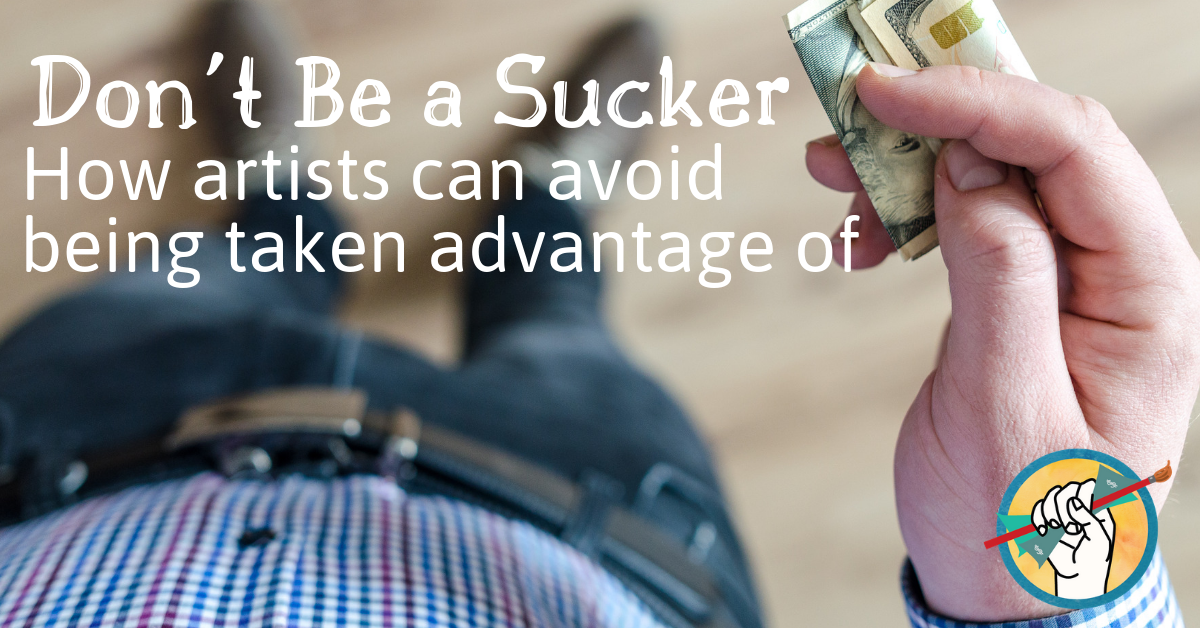
Common email and social media scams
Jennifer has been painting botanicals in watercolor for several years as a hobby. She has given away several pieces for birthdays and holidays, and even sold a few pieces to relatives and close friends. Everyone who sees her work immediately remarks “You should be selling these!” with wide eyes and an encouraging smile (never mind that these people are never the ones who buy anything). She has no clue where to start, but artists who sell their art successfully start with a website, right? She settles on WordPress with Shopify. She creates a Facebook and Instagram page for her burgeoning business, and begins to write a blog.
As her business begins to slowly grow, she begins to receive email inquiries about her work. She can hardly believe her eyes when she receives the following email:
“My name is Daniel Walter from Jacksonvile, Florida. The photos on your website are so fascinating and so amazing, looking at each piece of work i can easily see that you added so much dedicated in making each work come out to life, unfortunately i lost the website where i first saw your work but i was save your email address.
I would like to purchase some of your work for my wife as a surprise gift for our 20th anniversary. Please kindly send images and price of some of your art which are ready for immediate sale between the price range of $500- $5,000, I am flexible with price. I am writing you because i need your help to get back to your website to retrieve the details of your work that interest me or send me images of some of your new work with price.
Best Regards,
Daniel Walters”
At first it seems too good to be true, and for a while Jennifer excitedly sorts through her work to find the best pieces to send to Daniel. Which botanicals are ideal for an anniversary? Roses? Lilacs? Her mind is racing, and she goes back to re-read the email. That’s when it hits her.
Who misspells his own last name? And how exactly does one lose a website? Does he not know how to access his own browser history?
Jennifer’s heart sinks as she realizes that she is being taken for a ride. A quick Google search of the email text pulls up website after website with the same text almost verbatim, sometimes with different names and locations. Had she moved forward, he likely would have sent her a check for two or three times the agreed-upon amount, then ask her to wire the extra back to him.
It probably goes without saying at this point- it’s a scam.
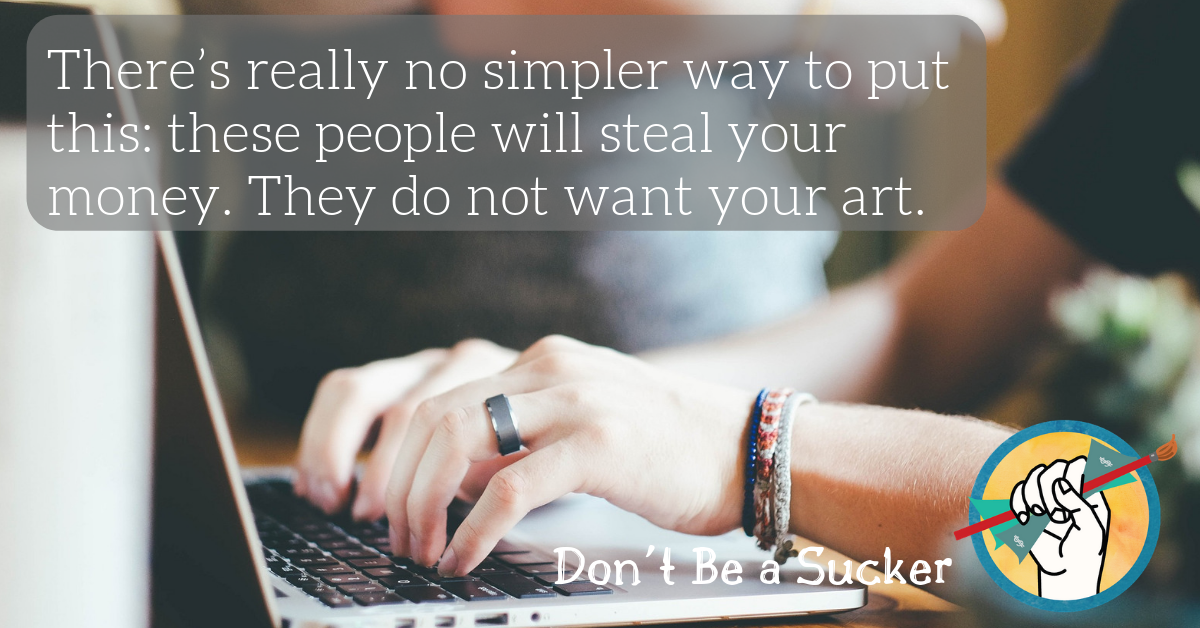
Signs that the email is a scam
First, scammers almost always have terrible grammar and spelling. English is usually not their first language. If you notice inconsistencies in the spelling of the name, email address or location, that’s your first red flag. Consider these other red flags:
- Did they “come across your website” or “see their wife looking at your website”?
- Despite having supposedly spent some time looking at your work, do they avoid the mention of any specifics in their email?
- If they gush over your art, is it in oddly general terms like “I can see you put much dedication in your work”?
- They may simply copy/paste the details of a particular piece they profess to be interested in.
When you respond to a scammer like this, they usually request to send you payment via a cashier’s check or similar. They may offer excuses about why they cannot talk on the phone, are often “out of the country on business” or are in the process of moving. They’re often celebrating their spouse’s birthday or an anniversary. They will send you an overpayment, and when you respond to them that they sent too much they will provide a lame excuse and then ask you to send the excess back to them via wire transfer. (Don’t do it.)
For a helpful and ever-growing collection of examples of email scams targeting artists, check out our post How to Recognize the Signs of an Art Scam and visit Stop Art Scams.
Risks of doing business with email scammers
There’s really no simpler way to put this: these people will steal your money. They do not want your art. If you wire back to them the excess of their overpayment, you will soon be notified that the original check bounced or was fake, and you’ll be out that money with no recourse. You will never hear from them again.
If you receive an email and you suspect it’s a scam, do a little research online. Search for other artists’ experiences with the copy of the email, the name of the scammer, etc. You may choose to engage the scammer a little to get more information out of them and see if further red flags pop up, but this isn’t necessary. If you have a bad feeling, delete the email and move on with your life.
Vanity galleries
Feeling annoyed and jaded after several interactions with potential collectors who turned out to be scammers, Jennifer begins to think that the wisest choice may be to sell her art through a gallery. “Let the gallery deal with the scammers,” she thinks, “and I can go back to spending most of my time doing what I love most: painting!”
She starts Google searching galleries in her area. She discovers quickly that this isn’t going to be as simple as she thought. Many of the galleries she comes across are closed to outside submissions, and others simply don’t mesh with her art style. She begins to feel very intimidated and discouraged. In the meantime, she continues working on her website and social media presence and slowly growing her audience.
After a few weeks, something surprising happens! She receives an email from a gallery thirty minutes from her house, and they’re interested in her work! Jennifer is over the moon with excitement. Who knew this would happen so quickly? She exchanges a few emails back and forth, performs a quick Google search, and heads out to meet the owner of the gallery in person.
Everything seems kosher- it’s a real world location in a fairly busy downtown area. The building is well lit and there is art on the walls. As she peruses the art, waiting for her appointment, she feels a bit of a gut check. The portraits on exhibition are surprising. Jennifer knows her art career is still in its early stages, but she can tell quality work when she sees it. This isn’t it. The work on the walls of the gallery isn’t impressionist or primitive. It’s… amateurish. Jennifer swallows hard and tries to convince herself that she’s just being nitpicky because she’s nervous.
When her meeting with the warm and amicable gallery owner begins, the fishy smell intensifies. He gushes over her work to the point of flattery. He then tells her that she can exhibit her work in the gallery for a month along with listings on the gallery’s website, listings in the gallery’s color catalog, and “career guidance” (whatever that means)… all for just $5,000.
Wait, what? Aren’t galleries supposed to help you make money by selling your art for a commission? Jennifer is taken aback at the amount she’s expected to pay up front for the privilege of maybe being able to sell her art through the gallery. She doesn’t have $5,000 to spend up front… she was hoping to make that money by selling her work through a gallery. Assured by the gallery owner that this is not only perfectly legal, but a perfectly normal way to conduct business, she heads home dejected and discouraged.
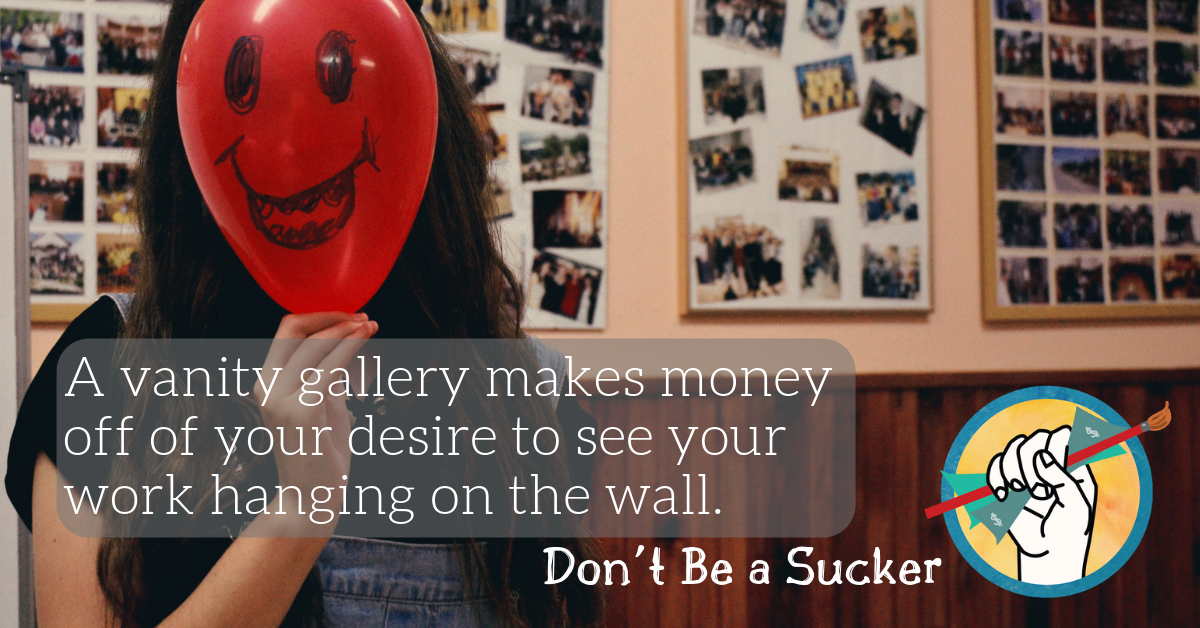
Signs that a gallery is a vanity gallery
Here are a few telltale signs to watch for anytime you’re introduced to a new prospective gallery. Consider carefully the following:
- Do they charge a fee in addition to or in place of a regular sales commission?
- Do they charge an extra fee for representation services?
- Do they charge a fee to be included on their website or in their catalog?
It becomes clear pretty quickly that the distinguishing factor that sets a vanity gallery apart is the fee structure. But why is this so harmful? Conventional galleries charge a pretty significant commission on all sales and can be restrictive with their artists’ online presence and outside sales as well. So why is it so wrong for a vanity gallery to charge a fee?
The key difference between a conventional gallery and a vanity gallery is that a conventional gallery is motivated to sell your work because when you make money, they make money. A vanity gallery makes money off of your desire to see your work hanging on the wall. Is this a scam, per se? Not if the gallery explains their policies clearly up front. Think about it as similar to self-publishing a book versus being published through a traditional publishing house. When you self-publish, you pay up-front for all costs associated with publication, and you must do all of your own marketing. And yes, a few authors do make it big this way. But they are in the minority.
Risks of doing business with a vanity gallery
The first risk of doing business with a vanity gallery is that you won’t make any money. As established above, the gallery makes its money off you. They are far less motivated to do the work of selling. You are going to be responsible for any selling that happens. The unfortunate truth is that an artist who is naive and optimistic enough to pay a vanity gallery is unlikely to have the business skills to sell their work profitably through the gallery.
The second, and perhaps most unfortunate, risk of doing business with a vanity gallery is that it can hurt your reputation and your chances of future success with conventional galleries. Most traditional galleries will be aware of common vanity galleries, and wary of representing artists with a history of showing their work in those spaces. The reason? While not always the case, it’s often true that an artist who pursues a vanity gallery is an artist whose work is not ready for a traditional gallery. Perhaps they haven’t refined their style, they haven’t produced work in a coherent series, or their work simply isn’t good enough yet. When an artist is more concerned with getting their art on the walls of a gallery than with improving and refining their work, it’s a red flag that not only will their work be difficult to sell, but they may also be difficult to work with.
Smarter alternatives to a vanity gallery
A conventional gallery is not the only way to make a good living selling your art. Check out our free resources on how to know if a gallery is the wrong choice for you, and how to succeed without a gallery:
How to Get Your Artwork in Front of Customers Without Relying on a Gallery
Why Artists Should Avoid Gallery Representation
If you’re committed to the gallery model, we have a lot of helpful posts on matching yourself with a good gallery (either on- or off-line) and making the most of the relationship:
Strategies for Gallery Success with Photographer Jeffrey Stone
Selling Your Art Online: Advice From 3 Online Gallery Leaders
How to Get Into a Gallery, and Succeed with a Gallery
Signing with a vanity gallery should never feel like it’s your only option. If you are just now embarking on your art selling journey, check out our free members-only library for a wide range of resources to help you sell your art- without paying someone else to put your art on their walls.
Third party print-on-demand marketplaces
Wisely, Jennifer decides against the vanity gallery. The more she researches the gallery and chats with artist friends, the more she understands that this early in her journey she isn’t really in a position to stake her entire career on paying money she doesn’t have for the chance to do all her own marketing and promotion. She would have to do all of that without the gallery anyway.
Jennifer moves on to researching new options, and that’s when she comes across the print-on-demand marketplace. A relative asks her if she would ever consider putting her designs on throw pillows, which has Jennifer scouring the internet for options. She comes across a large and popular website that will put her art on anything from laptop skins to leggings. Not only that, but she can create her own storefront, and the website will do all the work of creating,selling, and shipping the products! What’s not to love? She thinks this may perhaps be too good to be true.
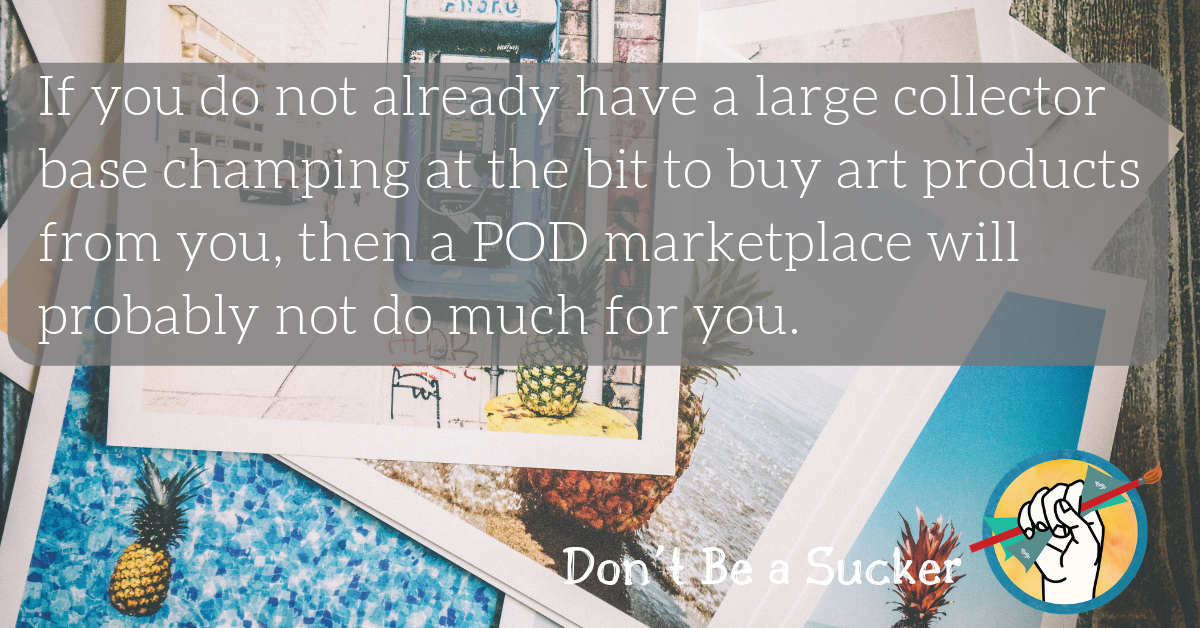
Signs that the print-on-demand marketplace isn’t going to be a lucrative choice for you
A print-on-demand marketplace is not a scam in any traditional sense of the word. But it is a business model that takes advantage of the incredible saturation of artists on the internet looking to make money for minimal effort. If you do not already have a large collector base champing at the bit to buy art products from you, or if you are not interested in putting in a consistently high level of effort over a long period of time, then a POD marketplace will probably not do much for you.
That said, it can be a useful extra income stream, so don’t discount the model entirely. But it’s important to enter in with both eyes wide open, aware that this is not a way to get a big break or get rich quick for the vast majority of artists. There are stories of artists who have found success with print-on-demand marketplaces. Print studio owner Patricia Vargas is one such artist who has found good success with Society6, but it’s worth noting that she was on the platform for quite some time before she got a lucky break, and it is not the only iron she has in the fire. Read our interview with Patricia here: https://theabundantartist.com/podcast28/
Risks of doing business with a print-on-demand marketplace
Unlike a vanity gallery, most print-on-demand marketplaces do not require an up-front fee, though there are a few exceptions. So there is little risk other than the time you’re going to put into a model that is unlikely to produce the return that it seems to promise.
Sizing, formatting, uploading images, pricing, and writing descriptions for the various products available on POD marketplaces can be incredibly time-consuming. This process is not too different from creating the listings to sell art on your own website, but the stark difference is that no one on your own website is going to take a significant percentage of the profit from you. Some POD sites will make a big deal of advertising that artists get to set their own markup. The result is that thousands of artists will list their work at the minimum markup just to attract shoppers looking for a deal, and it will be difficult to compete in the marketplace setting if your prices are higher- even if your work is worth the price.
We did a comprehensive review of the most popular print-on-demand marketplaces including their yearly costs, notable features, processing fees, and much more. To check out the spreadsheet, visit our free member library.
Smarter alternatives to a print-on-demand marketplace
As always, we recommend putting the bulk of your effort into selling on your own website. Why? When you sell on your own website,
- You retain 100% of the profit
- You retain customer information (many marketplaces don’t provide this information to the artist, robbing them of the opportunity to follow up and develop relationships)
- You set your own prices and markup
- You retain creative control, and you don’t have to worry about the content or quality of the art your work is displayed alongside.
If your primary concern is the availability of art products that you do not want to create or source yourself, then you may want to consider one of the apps created for Shopify stores, which allow you to integrate the app into your own website and retain all customer information. Some popular choices include Gooten, CGProPrints, and Pixels.com.
Being taken advantage of by family and friends
As Jennifer’s little art business very slowly grows, more and more of her friends and loved ones begin to take notice. She receives a phone call from an aunt who gushes over her work and then suggests that she’d love a print for her den. When Jennifer cheerfully announces the prices of her various prints, her aunt gets evasive, and finally changes the subject. What’s worse is the social media acquaintance who assumes that the fact that Jennifer is an artist means she wants to illustrate the children’s book their mom wrote. Or paint a mural in their kid’s bedroom. Or draw a portrait of their dog. She does not, and never has, done pet portraits, murals, or illustrations.
Jennifer hates to say no, especially to family and friends, and so she finds herself attempting art styles she has no interest in just to please people. She accepts pitifully low prices for commissions that take hours and hours to complete. She shakes off the gross feeling, trying to feel confident that she’s just being kind to her loved ones who certainly deserve it. If she isn’t working under extremely strict specifications and a cousin breathing down her neck to create something exactly right for his friend’s wedding gift, she’s flying by the seat of her pants when her uncle asks her to “paint something nice” for her aunt’s birthday and then gives no further details.
Jennifer feels burnt out, taken advantage of, and stressed. The joy of creating is gone, and she’s ready to throw in the towel altogether. What is so wrong with just being nice to friends and family? Why does she feel this way?
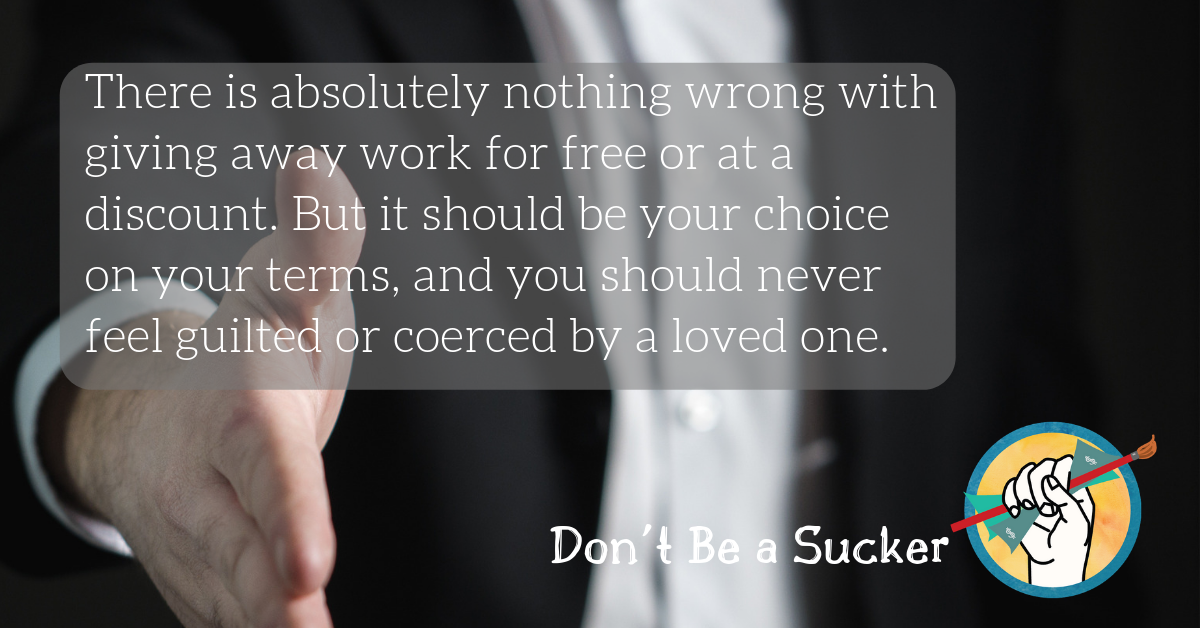
Signs your friends and family are taking advantage of you as an artist
Friends and family members of artists are notoriously bad at honoring reasonable professional boundaries. For anyone who is not an artist, it is difficult to fathom why a simple painting can command such high prices. It’s just a painting. Of course, artists know that what they’re truly selling is not the single painting. They’re selling the hours, weeks, months, and years of practice, effort, and learning that resulted in the ability to produce that painting. There may have been literal blood, sweat, and tears involved in the production of the art that seems, on the surface, so simple.
Only those with an extreme lack of self-awareness would dare to ask a real estate agent, an insurance salesman, or an electrician for free or heavily discounted work, even if they were a relative. Why? It’s much easier and perhaps more culturally acceptable to recognize the years of schooling and hard work that go into the formation of these professions.
And it’s also worth noting- there is absolutely nothing wrong with giving away work for free or at a discount. But it should be your choice on your terms, and you should never feel guilted or coerced by a loved one. Here are a few indicators that the transaction isn’t as healthy as it should be:
- You begin to feel resentful for the time and effort it’s requiring versus how much you’re being paid
- You’re worried that you won’t be left with enough time or resources to devote to better paying work
- The work is outside of your niche and it’s not bringing you fulfillment or joy
- You’re afraid to say “no” because of an impending guilt trip
Another variation of this risk (we wouldn’t call this one a scam) is organizations, particularly nonprofits, who solicit free art for events, fundraisers, silent auctions, etc. These organizations will often make promises of “exposure” and new sales, but these promises rarely materialize. There is nothing wrong with deciding to donate your art to a fundraiser- but it’s wisest to consider that piece of art as a total loss rather than an investment.
Smarter alternatives
So what’s the solution? You don’t have to be a jerk in order to prevent others from taking advantage of you. In fact, you may want to compose a series of canned responses you can give whenever a friend or relative asks for heavily discounted or free work, or asks you to create a piece of art outside of the niche you’ve settled on. Then all you have to do is stick to the script. Some examples:
- Can I have this piece at a cheaper price/for free? Hey there, I wish I could give every piece away for free because I love to share the joy my art brings me with the world! Unfortunately, this is a significant part of my livelihood and in order to meet my bottom line I’ve got to stick to my stated prices. Thank you for understanding! If you’re looking for something in a lower price range, have you checked out my (3”x5” prints, etc)?
- Can you do a portrait of my dog (or something else you don’t want to do)? Your dog is so cute! I can see why you want to preserve his handsome mug in a portrait, and I love that you thought of me. Unfortunately, I’m not your gal. I have spent the past several years working on my (botanical illustrations) and I don’t think I would be able to do your little guy justice. Can I recommend you to my friend who does pet portraits exclusively?
- I don’t want you to sell prints of the commission you’re doing for me. That way it will be more valuable and unique. Actually, there’s not always much overlap between those who buy prints and those who buy and commission original art. So selling prints of the work is very unlikely to devalue the original piece. If you’re very serious about exclusivity, I’d be happy to draw up a contract for you to reflect the terms as well as the 3x price increase that is standard to exclusivity.
Here’s what we want you to take away from this piece: you can be a beautiful, sensitive soul who sees the world through your unique artistic lens, and you still don’t have to be a sucker. Take some time to educate yourself on common scams, and as you grow your business be sure to keep both eyes wide open. Be aware that growing your art business takes time- usually years and years. This is normal and healthy, as impatient as it can make you feel. Any opportunity that promises to skyrocket you to fame or pay you radically more than you’re accustomed to should be met with slow and careful skepticism. Ask plenty of questions, do your research, and be sure to calculate the risks whenever you enter into a new or questionable transaction.
If you’ve read to the end of this piece and you realize that you may need a little help to grow the firm backbone that will be essential to protecting your business, we highly recommend joining a community of professional artists who will support you, compare notes, and help you avoid being taken advantage of. That’s a huge part of why we created The Abundant Artist Association. Learn more here: https://theabundantartist.com/association-v2/
Hi.
It seems I’m familiar with all of these traps and their variations (for example, giving photos for free for “just a wallpaper” and “you greater exposure”) by myself…
Great article, thanks!
This info was incredibly helpful, and steered me clear of a vanity gallery in Europe. Thank you for saving me 250 euro:) Europe will have to wait for my spellwork paintings.